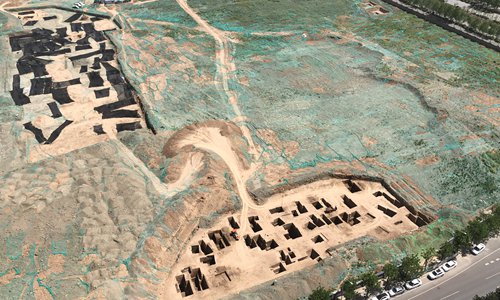IN-DEPTH / IN-DEPTH
Frequent discoveries of underground relics in Xi’an a bittersweet treasure for city construction
Digging up the past

An aerial view of an archaeological excavation site in Xi'an, Northwest China's Shaanxi Province, which was a shopping mall construction site before the discovery of an ancient tomb. Photo: Li Lei/GT
"The archaeological team took over the construction site several weeks ago," a security guard outside the site in Xi'an, Northwest China's Shaanxi Province, told the Global Times.From the top floor of a building next to the construction site, located along the Xifeng Second Road, a number of holes neatly dug by an archaeological team can be seen. According to the security guard, the team was stationed there after an ancient tomb was discovered during the digging of the foundation for a giant shopping mall including an Ikea store.
It is not unusual for relics and heritages to be discovered underground in Xi'an, a city with a long and rich history of more than 3,000 years. More and more historical sites and relics have been discovered during the city's infrastructure construction, making the protection and preservation of these relics a matter of public concern.
Changing course
The newly discovered ancient tombs in a couple of construction sites in Xi'an have made the city's cultural heritage administration a busy department.
A notice posted by the Shaanxi Provincial Cultural Heritage Administration on its Sina Weibo account on March 1 said that a relic site from the era of Feiqiu, one of the capital cities in the Warring States period more than 2,000 years ago, was discovered at a construction site for the city's subway line 5, which could result in the subway being re-routed.
The post was later deleted, but not before it sparked a wave of discussions on the city's cultural and archaeological workers, with many calling them the busiest archaeological team in history.
During the construction of the city's subway line 2, more than 3,000 cultural relics and 260 ancient tombs were excavated. It is not rare to see a construction project in the city turn into an archaeological excavation site due to the discovery of ancient tombs.
The city has a long list of construction site-turned archaeological projects. Many ancient tombs of famous historical figures were discovered during the construction of universities in the city.
The tomb of a top judicial official of the Han Dynasty (206 BC-220 AD) was found on the construction site of the Northwest University of Political Science and Law, and the tomb of a princess from the Tang Dynasty (618-907) was discovered on the campus of Xi'an University of Technology. Some comments online said that campus construction in Xi'an is more like a large-scale treasure hunt, and as long as you dig deep enough, museums can be found everywhere in Xi'an.
Winding the subways
However, there are also concerns over the protection and preservation of the relics, as there are fears that cultural heritage authorities might not have enough manpower to handle the large number of newly discovered archaeological sites.
Due to the rich underground heritages, "prior to any construction project in Xi'an, an archaeological survey is carried out, which is rare in China," Wang Zili, deputy director of the Xi'an Institute for the Preservation of Cultural Heritage, told the People's Daily.
Wang said that the city's cultural heritage administration is involved in every subway project, from route planning to construction. During the planning period, all the major known heritage sites are avoided, and an archaeological investigation is carried out before the construction of each subway station and control station.
If an ancient tomb or relic site is found, archaeological excavation takes place prior to construction.
Wang explained that Xi'an has had successful experience in dealing with the discovery of cultural relics at construction sites, and re-routing is not the only option. For example, during the construction of the city's subway line 2, a raft of protective engineering measures were undertaken when the tunnel was built under ancient buildings such as the Belt Tower and the Drum Tower.
"Like a surgery, no cultural relic is treated carelessly, and each one of them is treated according to standard procedure, whatever the size," explained Tang Long, head of the archaeology department at Xi'an's cultural heritage administration.
Tang said that all cultural relics found underground should be processed by archaeologists according to the proper procedures, which include photography, measuring, site protection, reinforcement, numbering, packaging and excavation.
According to the cultural heritage administration, archaeological excavation work on the city's existing four subway lines has wrapped up, while archaeological surveys and excavations are still underway for lines 5 and 6 and the second-phase of line 1, which are currently under construction.
